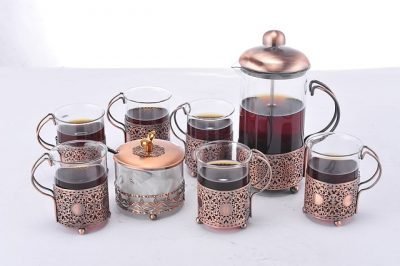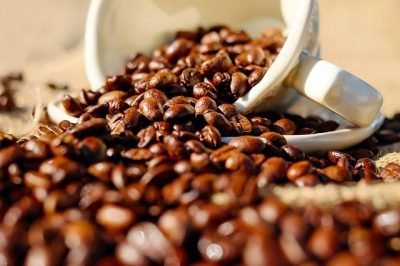
A French press is more versatile than many of us give it credit for – with a few mindful tweaks, we can whip up a perfectly flavorful and rich cup of not just coffee, but also tea. While the drip versus press debate is likely going to continue into the unforeseeable future, press coffee and tea have their own merits, when prepared properly. In fact, French press enthusiasts swear that a cup brewed in a plunger or press pot is several cuts above in flavor and depth compared to anything you could stir up with some instant coffee or a tea bag – once you have the basics down, you’ll never have to walk into a Starbucks again for a $3 morning cup of caffeine.
Coffee

There tends to be a misconception, sometimes, that French press coffee is usually bitter and muddy to taste, saturated with sediment-like grounds. This, however, is often because a French press isn’t designed to work with fine, pre-ground beans. The finer the coffee, the more likely it’ll clog up the mesh filter through which the brew is extracted, muddying up the drink you finally pour out because the screen wasn’t able to capture the too-fine grounds. For French press coffee, coarser coffee granules are recommended, with coffee enthusiasts recommending opting for coffee beans you grind at home using the coarsest setting of your grinder, or have ground in a specialty shop or your local coffee shop. The bigger grounds, when the press is pushed down, won’t get forced through the mesh screen – instead, as the coffee steeps, they absorb and hold water, so when you push down the plunger the pressure extracts all the rich flavor from the grounds without any sediment trickling through.
Tea
The press method works brilliantly for loose leaf tea as well – moderating the steeping time depending on your choice of tea and nailing the ratio of water to tea leaves can leave you with a more full-bodied cup than a simple steeping session can.
Water
Specifically, the temperature of the water. If the water is too hot, the coffee or tea risks getting overextracted – too-warm water is often to blame for a bitter hot beverage. On the other hand, tepid or lukewarm water doesn’t work as well to extract flavor, and leaves you with a weak-tasting, bland drink instead.

Getting the water temperature right makes all the difference for the end results of a French press prepared beverage. For different types of teas, the ideal temperature ranges vary – for instance, black teas brew better between 190-200 degrees Fahrenheit, while the ideal range for steeping green teas is between 150-170 degrees Fahrenheit. One way of nailing the right temperature is bringing water to a boil, removing it and then moderating the temperature with a kitchen thermometer until it’s cooled to the desired range. While this might seem too much of a fuss to carry out for a cuppa, a couple of rounds of brewing and you’ll find yourself intuitively capable of telling if the water is at the right temperature by how vigorously it’s boiling and the size of the bubbles – though, of course, there’s always the alternative of going for a variable temperature electric kettle you can set to warm water to a specific temperature. The payoff is a sumptuous cup of tea with depth and taste, so it’s a win-win situation.
For coffee, the ideal temperature is roughly 195 degrees Fahrenheit. One trick of getting your water down to this temperature without whipping out a thermometer is to bring the water to boil, and then leave it to cool for about a minute before pouring it into your French press – which brings us to the actual process of brewing.
French press basics
Now that we’ve got our pick of coffee or tea set aside, and figured out the right temperature for the water to steep it in, we need to figure out the right ratios. For a typical 8 ounce cup of coffee, the recommended ratio is two rounded tablespoons of ground coffee per a cup of water, while for tea, a single teaspoon of loose leaf tea leaves is recommended per 6 ounces and one teaspoon of water.
Once you’ve done the math and figured out how many ounces of water you need for the number of servings you plan to brew, we get down to the actual business of using the press. Familiarize yourself with its components, and what they do. Most presses come with a clear glass carafe, though there are metal and plastic alternatives available too. Once you’ve removed the lid and plunger, your coffee beans or tea leaves go into this carafe, followed by hot water within the desired temperature range. Then you simply replace the lid, and let it all steep.
For coffee beans, the recommended time for a cup of coffee which means business is about 4 minutes. For tea, the steep time varies depending on the type of tea leaves you’re using – black and red teas appreciate a good 4-minute soak, green tea prefers just over 2-3 minutes, while herbal teas can be steeped for up to 15 minutes.
Once you’ve given the grounds or leaves a chance to soak up the water, the warmth teasing out a harmonized blend of flavor, it’s time to do the pressing this device gets its name for. Slowly push the plunger downward – the pressure squeezes out the flavor-infused liquid through a fine mesh filter, catching all the largish grounds or crushed leaves and holding them down so you don’t end up with lumps and sediment in your drink. Once you’re done pressing, pour out your cupfuls immediately, since leaving the liquid in the press will keep it brewing – it’ll grow bitter the longer it stays in there. If you’re not planning to consume it immediately, you can store it in a thermos.
After that, it’s just a matter of adding sugar, milk or creamer to your preference, and voila, you have in your hands a cup or mug of decadent coffee or tea brewed to perfection, at a fraction of the cost of visiting a café and, once you get the basics down, with very little effort. Maintaining the press is a simple matter of keeping it clean, especially the plunger and the mesh screen to ensure smooth draining and pressing every time you’re in the mood for a pick me up.